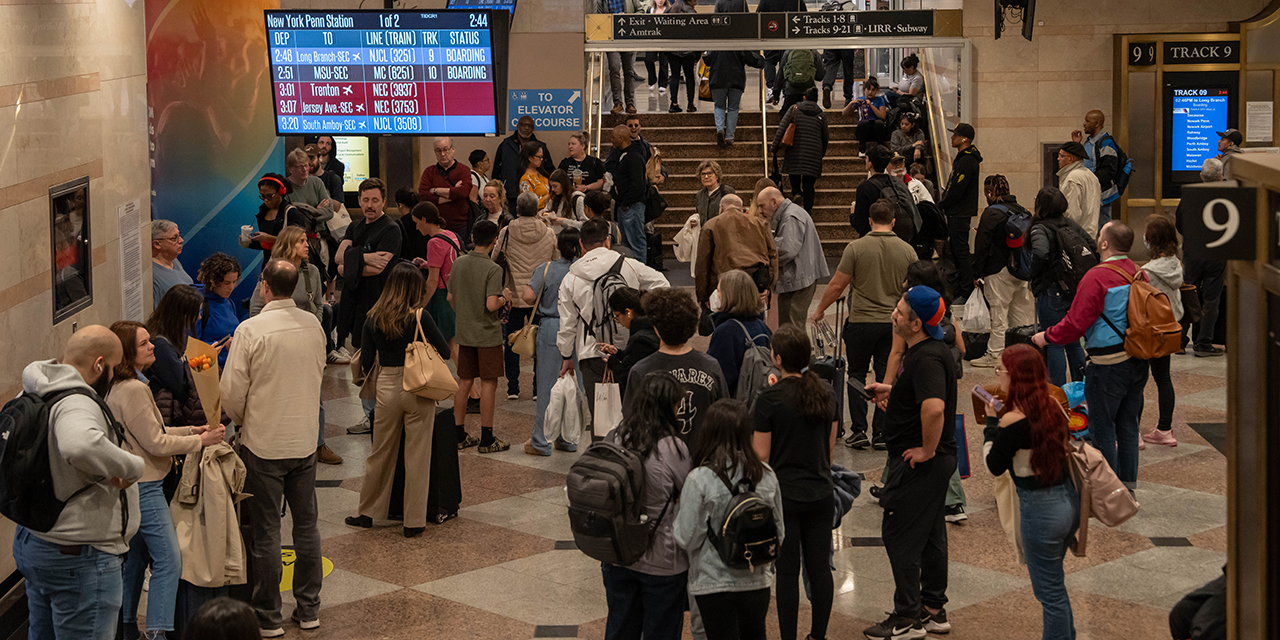
New Yorkers have greeted U.S. Transportation Secretary Sean Duffy’s announcement last week of a federal takeover of the Pennsylvania Station improvement project with weary skepticism. That skepticism is warranted. The Gordian knot of Penn Station has defeated decades of well-intentioned efforts at improvement by various levels of government.
Despite numerous proposals and partial renovations, Penn Station remains hamstrung by deep-rooted engineering, financial, and logistical challenges. Any federal plan to overhaul it will need to overcome these obstacles—and so far, the Trump administration has offered no concrete blueprint to silence the skeptics.
Finally, a reason to check your email.
Sign up for our free newsletter today.
Many point to the original sin behind today’s problems: the 1960s demolition of the old Penn Station—a grand Beaux-Arts structure, designed by the famed architectural firm McKim, Mead & White—and the subsequent construction of Madison Square Garden atop the reconfigured underground station. The result was a facility that was cramped, claustrophobic, and dangerously ill-suited to emergencies. A single rush-hour service delay could trigger dangerous crush-crowding, forcing station entrances to close. Evacuation routes were inadequate to handle such conditions in an emergency.
Since the 1960s, however, the pedestrian experience in the station has significantly improved, thanks to the construction of new concourses (the Moynihan Train Hall and the New Jersey Transit concourse) and new entrances to Seventh and Eighth Avenues, as well as West 33rd and 34th Streets. Corridors are now wider and less dingy.
Some of the flaws that remain are a consequence of the demolition of the original Penn Station. Notably, the station has no natural light, in contrast with the original Central Waiting Room and Train Concourse, which made arrival in New York City by train an awe-inspiring experience. More prosaically, the rebuilt station is filled with back-of-house space and mechanical rooms that preclude further corridor widening and the construction of additional stairs, elevators, and escalators down to the train platforms.
Moving Madison Square Garden would obviously create many possibilities for reconstructing a magnificent and light-filled station. But it would be expensive and difficult. The Garden owns its site, has made a considerable capital investment, and would need to be compensated for its property value. The venue also enjoys a perpetual property-tax exemption at its current location and would want that to continue at a new one. Finally, a new facility would need to work operationally and be financially feasible.
As a New York City planner, I worked in the mid-2000s on an initiative, supported by the Garden, to move the facility to the rear of the Farley Post Office Building, west of the Moynihan Train Hall. The plan would have compensated the Garden through the sale of its development rights to a series of receiving sites in the neighborhood.
The proposal never quite worked financially and fell apart in the 2008 economic downturn. A scaled-back version, in which the Garden would have remained above the station, ultimately won state approval but also never achieved financial feasibility. In 2023, New York governor Kathy Hochul announced that the state would move forward with renovating the station, independent of any redevelopment deal. Transportation Secretary Duffy spiked that moribund plan.
Another option, recently floated, is “Grand Penn.” The plan’s sponsor, the Grand Penn Community Alliance, is supported by hedge-fund manager Thomas Klingenstein, a prominent financial backer of U.S. President Donald Trump.
Grand Penn’s proposal would move Madison Square Garden to the former Hotel Pennsylvania site on Seventh Avenue, between West 32nd and West 33rd Streets, across from Penn Station. But it’s unclear whether the arena would even fit on the smaller site. Grand Penn’s rendering shows the facility cantilevered over the 33rd Street sidewalk—something the city is generally hesitant to approve. It’s also uncertain whether Madison Square Garden wants to move there, or whether the site’s owner, Vornado Realty Trust, would welcome it.
With the Garden relocated, Grand Penn envisions a glass-enclosed pavilion—evocative of McKim, Mead & White’s original design—just west of the 2 Penn Plaza office tower, above a rebuilt Central Waiting Room. To the west, fronting Eighth Avenue, the plan calls for a ground-level park, with a reconstructed train concourse below.
That proposal would cost multiple billions of dollars but would not address flaws resulting from the original site planning and track design, dating to the early twentieth century. The city permitted the Pennsylvania Railroad to close West 32nd Street, west of Seventh Avenue, and build beneath West 33rd and West 31st Streets. However, this required the railroad’s agents to purchase, surreptitiously, the privately owned land lining those streets. To minimize land acquisition, the railroad limited the station’s below-grade footprint to the three side streets and the two intervening city blocks—a total of 580 feet from north to south. Within that footprint are 11 platforms and 21 tracks, as well as retaining walls and support columns for the structure above. The upshot is that most platforms are narrow, difficult to exit, and unsafe for a full rush-hour passenger crowd to wait on. That’s why departing passengers must remain on the level above until their train’s track is announced, a few minutes before departure.
How trains approach the station poses another challenge. Just two tracks lead in from New Jersey, while four approach from Queens. The need for additional capacity from the west has long been clear, especially as commuter services that once terminated in Hoboken and Jersey City were rerouted onto the Northeast Corridor tracks into Manhattan.
A proposal sponsored by New Jersey Transit and the Port Authority, which would have built two new tracks under the Hudson River and a new station under West 34th Street, was cancelled by then-New Jersey governor Chris Christie in 2010. The successor Gateway Program, sponsored by Amtrak, includes the Hudson Tunnel Project, now underway. That project will construct a two-track tunnel from New Jersey into Penn Station and allow the rehabilitation of the existing North River tunnels.
Yet, because of capacity constraints within the station and in New Jersey, the Hudson Tunnel Project will not allow increases in rush-hour service—providing that additional service will require multiple projects that are neither approved nor currently funded. One is a Penn Station expansion that would involve acquiring the entire city block immediately south of the station, as well as portions of two other city blocks.
It is highly unlikely that any level of government would approve—let alone fund—the multibillion-dollar acquisition of this property over the objections of owners and residents. That’s why transit advocates are increasingly focused on the potential of “through-running.” In this scenario, Penn Station would operate less like a terminal—where trains enter and exit from the same direction—and more like a true station, with trains from New Jersey continuing through to Queens, and vice versa. Through-running could improve train speeds, ease congestion, and allow for track consolidation, making it possible to widen platforms and enhance passenger flow.
Through-running comes with its own costs, though, amounting to billions of dollars. It would also require engineering improvements—such as a unified power system for all railroads—and the construction of new connecting tracks outside Manhattan. Still, the plan has the virtue of not requiring the impractical Penn Station South expansion. The catch: it would demand unprecedented cooperation among the region’s railroads—and so far, the railroads are not on board.
In sum, Penn Station has vast problems that can be solved only by the commitment of vast resources—not all of which can come from the public sector. And if private capital is to be part of the solution, any successful plan must offer investors a reasonable return. It must also overcome long-standing political, institutional, and technological obstacles.
The Trump administration has yet to reveal any innovative ideas it has in mind. For the moment, the skeptics have the best arguments.
Photo by Adam Gray/Getty Images
Source link















